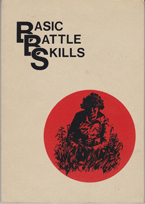Basic Battle Skills
Basic Battle Skills |
|
|---|---|
| [[File:|frameless|alt=]] | |
Front cover of "Basic Battle Skills" |
|
| Author | British Army |
| Language | English |
| Publisher | Ministry of Defence |
| Publication Date | 1980 |
Basic Battle Skills is a comprehensive manual published by the British Army to provide soldiers with essential skills and knowledge required for combat situations. The manual covers a wide range of topics, from individual soldier skills to small unit tactics, and is designed to be a practical guide for soldiers in the field.
Contents[edit | edit source]
The manual is structured to cover various aspects of battlefield skills, including:
- Individual Skills: This section includes basic soldiering skills such as camouflage, movement, and fieldcraft.
- Weapons Handling: Detailed instructions on the use and maintenance of personal and crew-served weapons.
- Tactics: Covers small unit tactics, including fire and maneuver, patrolling, and ambush techniques.
- Survival Skills: Information on survival in different environments, including first aid, navigation, and sustenance.
- Communication: Effective use of communication equipment and protocols in the field.
Key Concepts[edit | edit source]
Camouflage and Concealment[edit | edit source]
Camouflage is the use of materials, coloration, or illumination for concealment, either by making animals or objects hard to see (crypsis), or by disguising them as something else (mimesis). The manual provides techniques for effective camouflage in various environments.
Movement Techniques[edit | edit source]
Movement techniques are crucial for maintaining stealth and avoiding detection. The manual describes different methods of movement, such as crawling, walking, and running, and when to use each technique.
Fire and Maneuver[edit | edit source]
Fire and maneuver is a military tactic that uses suppressive fire to decrease the enemy's ability to return fire, while friendly forces advance. The manual outlines the principles of fire and maneuver, emphasizing coordination and communication.
Patrolling[edit | edit source]
Patrolling is a key skill for reconnaissance and security. The manual details different types of patrols, such as reconnaissance and combat patrols, and the planning and execution of patrol missions.
First Aid and Survival[edit | edit source]
Basic first aid skills are essential for treating injuries in the field. The manual includes instructions on treating common battlefield injuries and survival techniques for various environments.
Diagrams and Illustrations[edit | edit source]
The manual includes numerous diagrams and illustrations to aid in understanding the concepts and techniques described.
Also see[edit | edit source]
Search WikiMD
Ad.Tired of being Overweight? Try W8MD's physician weight loss program.
Semaglutide (Ozempic / Wegovy and Tirzepatide (Mounjaro / Zepbound) available.
Advertise on WikiMD
|
WikiMD's Wellness Encyclopedia |
| Let Food Be Thy Medicine Medicine Thy Food - Hippocrates |
Translate this page: - East Asian
中文,
日本,
한국어,
South Asian
हिन्दी,
தமிழ்,
తెలుగు,
Urdu,
ಕನ್ನಡ,
Southeast Asian
Indonesian,
Vietnamese,
Thai,
မြန်မာဘာသာ,
বাংলা
European
español,
Deutsch,
français,
Greek,
português do Brasil,
polski,
română,
русский,
Nederlands,
norsk,
svenska,
suomi,
Italian
Middle Eastern & African
عربى,
Turkish,
Persian,
Hebrew,
Afrikaans,
isiZulu,
Kiswahili,
Other
Bulgarian,
Hungarian,
Czech,
Swedish,
മലയാളം,
मराठी,
ਪੰਜਾਬੀ,
ગુજરાતી,
Portuguese,
Ukrainian
Medical Disclaimer: WikiMD is not a substitute for professional medical advice. The information on WikiMD is provided as an information resource only, may be incorrect, outdated or misleading, and is not to be used or relied on for any diagnostic or treatment purposes. Please consult your health care provider before making any healthcare decisions or for guidance about a specific medical condition. WikiMD expressly disclaims responsibility, and shall have no liability, for any damages, loss, injury, or liability whatsoever suffered as a result of your reliance on the information contained in this site. By visiting this site you agree to the foregoing terms and conditions, which may from time to time be changed or supplemented by WikiMD. If you do not agree to the foregoing terms and conditions, you should not enter or use this site. See full disclaimer.
Credits:Most images are courtesy of Wikimedia commons, and templates Wikipedia, licensed under CC BY SA or similar.
Contributors: Prab R. Tumpati, MD



